Accounting Theory and Practice - PDF
VerifiedAdded on 2021/05/30
|17
|3929
|38
AI Summary
Contribute Materials
Your contribution can guide someone’s learning journey. Share your
documents today.
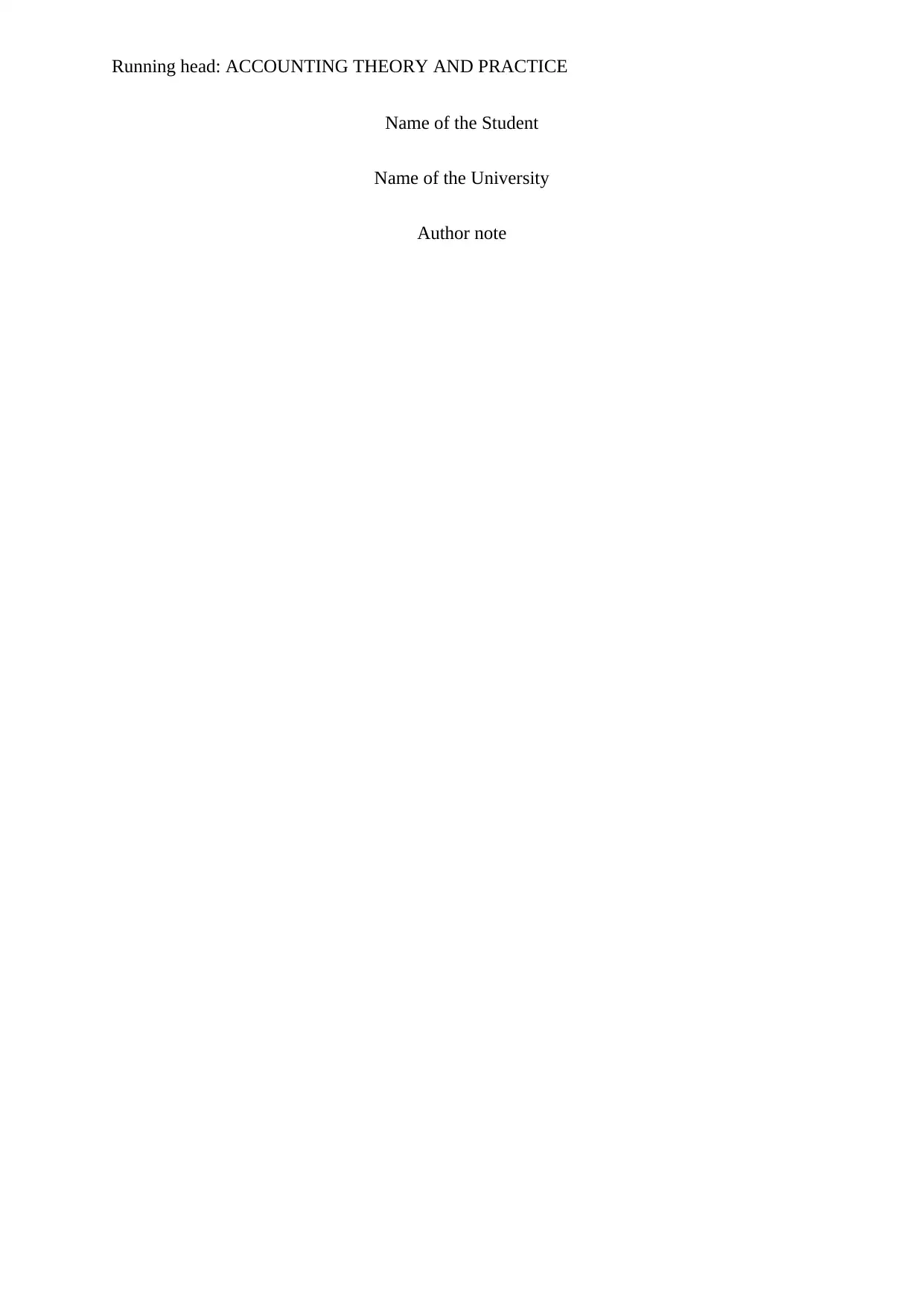
Running head: ACCOUNTING THEORY AND PRACTICE
Name of the Student
Name of the University
Author note
Name of the Student
Name of the University
Author note
Secure Best Marks with AI Grader
Need help grading? Try our AI Grader for instant feedback on your assignments.
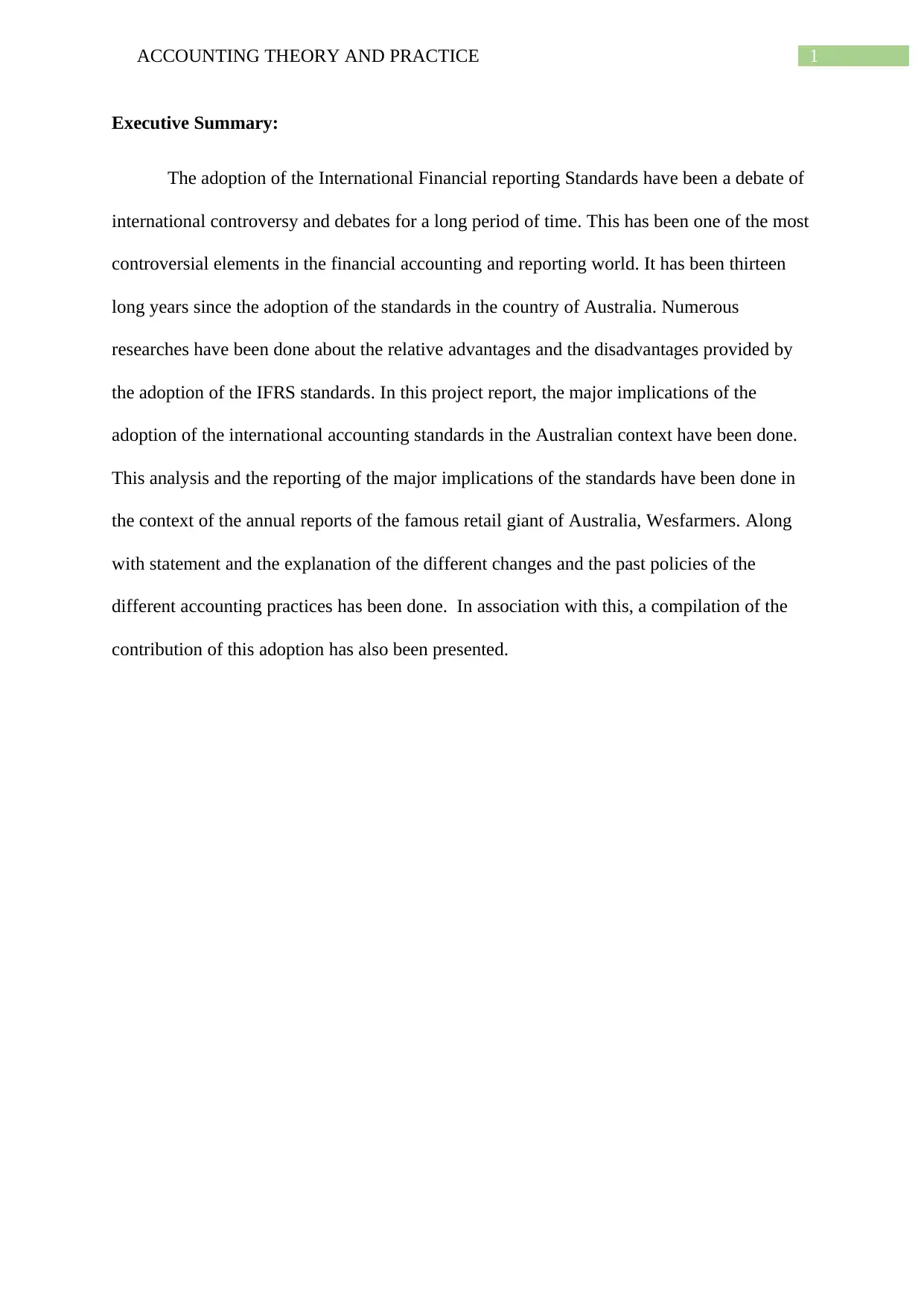
1ACCOUNTING THEORY AND PRACTICE
Executive Summary:
The adoption of the International Financial reporting Standards have been a debate of
international controversy and debates for a long period of time. This has been one of the most
controversial elements in the financial accounting and reporting world. It has been thirteen
long years since the adoption of the standards in the country of Australia. Numerous
researches have been done about the relative advantages and the disadvantages provided by
the adoption of the IFRS standards. In this project report, the major implications of the
adoption of the international accounting standards in the Australian context have been done.
This analysis and the reporting of the major implications of the standards have been done in
the context of the annual reports of the famous retail giant of Australia, Wesfarmers. Along
with statement and the explanation of the different changes and the past policies of the
different accounting practices has been done. In association with this, a compilation of the
contribution of this adoption has also been presented.
Executive Summary:
The adoption of the International Financial reporting Standards have been a debate of
international controversy and debates for a long period of time. This has been one of the most
controversial elements in the financial accounting and reporting world. It has been thirteen
long years since the adoption of the standards in the country of Australia. Numerous
researches have been done about the relative advantages and the disadvantages provided by
the adoption of the IFRS standards. In this project report, the major implications of the
adoption of the international accounting standards in the Australian context have been done.
This analysis and the reporting of the major implications of the standards have been done in
the context of the annual reports of the famous retail giant of Australia, Wesfarmers. Along
with statement and the explanation of the different changes and the past policies of the
different accounting practices has been done. In association with this, a compilation of the
contribution of this adoption has also been presented.
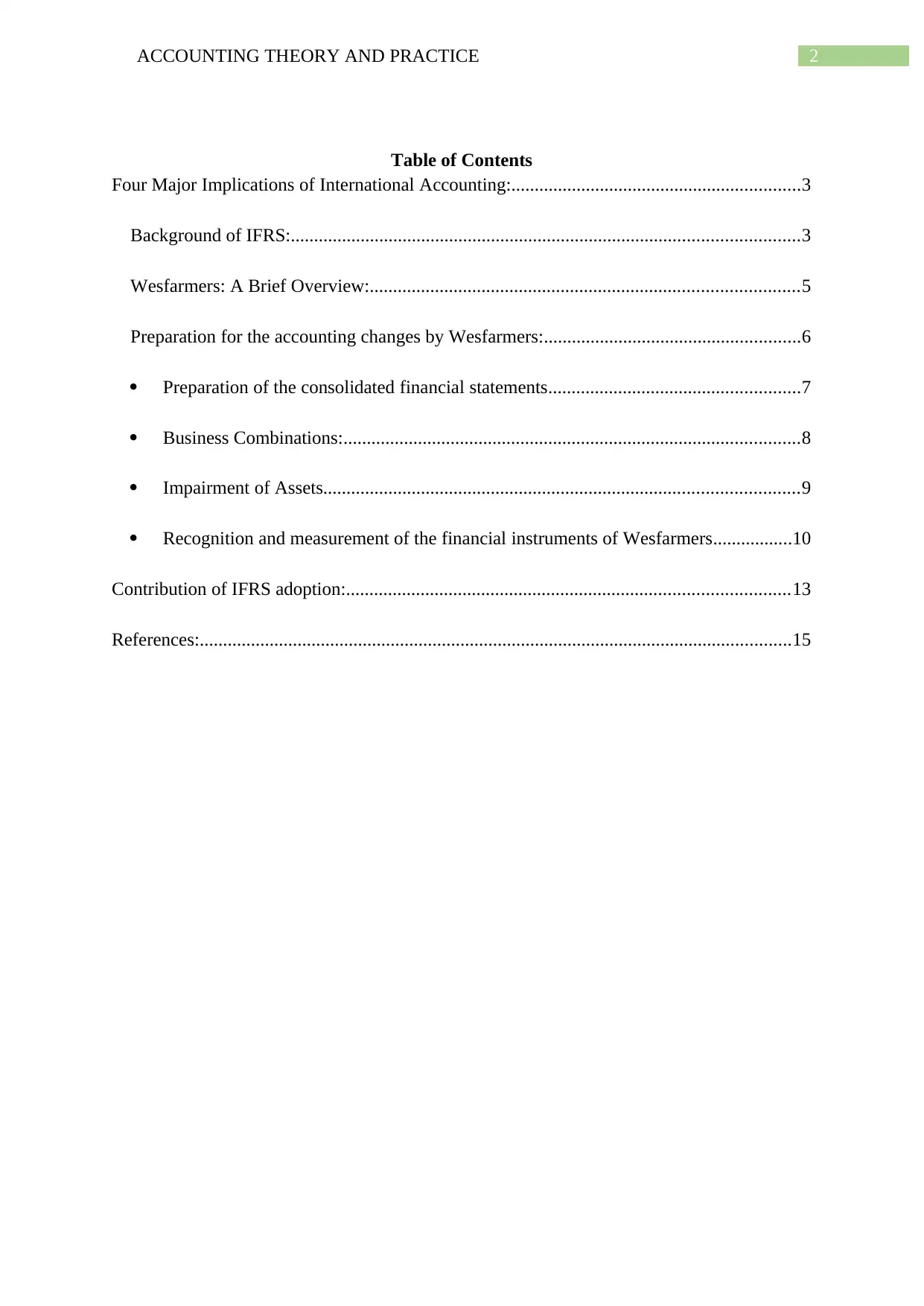
2ACCOUNTING THEORY AND PRACTICE
Table of Contents
Four Major Implications of International Accounting:..............................................................3
Background of IFRS:.............................................................................................................3
Wesfarmers: A Brief Overview:............................................................................................5
Preparation for the accounting changes by Wesfarmers:.......................................................6
Preparation of the consolidated financial statements......................................................7
Business Combinations:..................................................................................................8
Impairment of Assets......................................................................................................9
Recognition and measurement of the financial instruments of Wesfarmers.................10
Contribution of IFRS adoption:...............................................................................................13
References:...............................................................................................................................15
Table of Contents
Four Major Implications of International Accounting:..............................................................3
Background of IFRS:.............................................................................................................3
Wesfarmers: A Brief Overview:............................................................................................5
Preparation for the accounting changes by Wesfarmers:.......................................................6
Preparation of the consolidated financial statements......................................................7
Business Combinations:..................................................................................................8
Impairment of Assets......................................................................................................9
Recognition and measurement of the financial instruments of Wesfarmers.................10
Contribution of IFRS adoption:...............................................................................................13
References:...............................................................................................................................15
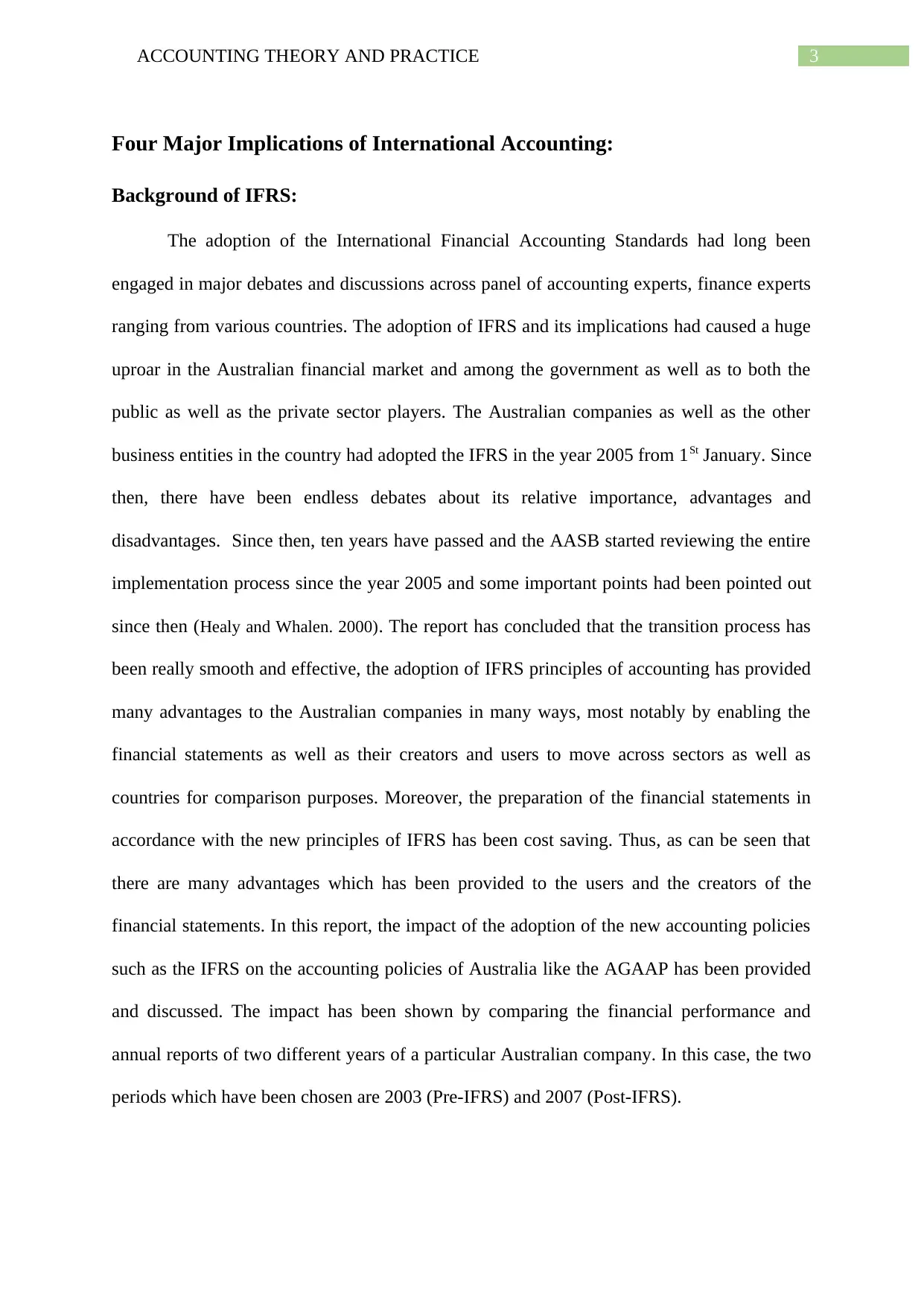
3ACCOUNTING THEORY AND PRACTICE
Four Major Implications of International Accounting:
Background of IFRS:
The adoption of the International Financial Accounting Standards had long been
engaged in major debates and discussions across panel of accounting experts, finance experts
ranging from various countries. The adoption of IFRS and its implications had caused a huge
uproar in the Australian financial market and among the government as well as to both the
public as well as the private sector players. The Australian companies as well as the other
business entities in the country had adopted the IFRS in the year 2005 from 1St January. Since
then, there have been endless debates about its relative importance, advantages and
disadvantages. Since then, ten years have passed and the AASB started reviewing the entire
implementation process since the year 2005 and some important points had been pointed out
since then (Healy and Whalen. 2000). The report has concluded that the transition process has
been really smooth and effective, the adoption of IFRS principles of accounting has provided
many advantages to the Australian companies in many ways, most notably by enabling the
financial statements as well as their creators and users to move across sectors as well as
countries for comparison purposes. Moreover, the preparation of the financial statements in
accordance with the new principles of IFRS has been cost saving. Thus, as can be seen that
there are many advantages which has been provided to the users and the creators of the
financial statements. In this report, the impact of the adoption of the new accounting policies
such as the IFRS on the accounting policies of Australia like the AGAAP has been provided
and discussed. The impact has been shown by comparing the financial performance and
annual reports of two different years of a particular Australian company. In this case, the two
periods which have been chosen are 2003 (Pre-IFRS) and 2007 (Post-IFRS).
Four Major Implications of International Accounting:
Background of IFRS:
The adoption of the International Financial Accounting Standards had long been
engaged in major debates and discussions across panel of accounting experts, finance experts
ranging from various countries. The adoption of IFRS and its implications had caused a huge
uproar in the Australian financial market and among the government as well as to both the
public as well as the private sector players. The Australian companies as well as the other
business entities in the country had adopted the IFRS in the year 2005 from 1St January. Since
then, there have been endless debates about its relative importance, advantages and
disadvantages. Since then, ten years have passed and the AASB started reviewing the entire
implementation process since the year 2005 and some important points had been pointed out
since then (Healy and Whalen. 2000). The report has concluded that the transition process has
been really smooth and effective, the adoption of IFRS principles of accounting has provided
many advantages to the Australian companies in many ways, most notably by enabling the
financial statements as well as their creators and users to move across sectors as well as
countries for comparison purposes. Moreover, the preparation of the financial statements in
accordance with the new principles of IFRS has been cost saving. Thus, as can be seen that
there are many advantages which has been provided to the users and the creators of the
financial statements. In this report, the impact of the adoption of the new accounting policies
such as the IFRS on the accounting policies of Australia like the AGAAP has been provided
and discussed. The impact has been shown by comparing the financial performance and
annual reports of two different years of a particular Australian company. In this case, the two
periods which have been chosen are 2003 (Pre-IFRS) and 2007 (Post-IFRS).
Secure Best Marks with AI Grader
Need help grading? Try our AI Grader for instant feedback on your assignments.
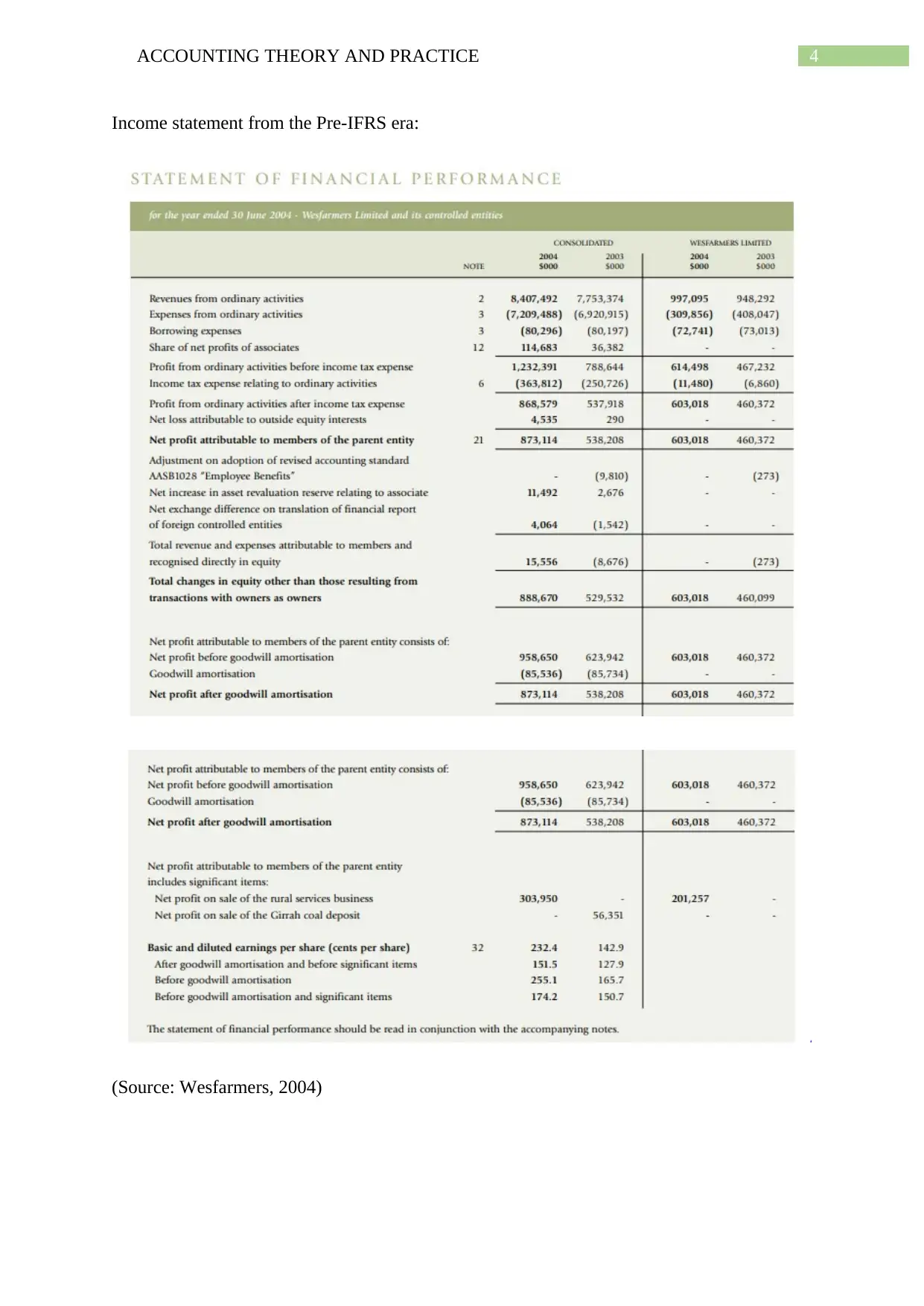
4ACCOUNTING THEORY AND PRACTICE
Income statement from the Pre-IFRS era:
(Source: Wesfarmers, 2004)
Income statement from the Pre-IFRS era:
(Source: Wesfarmers, 2004)
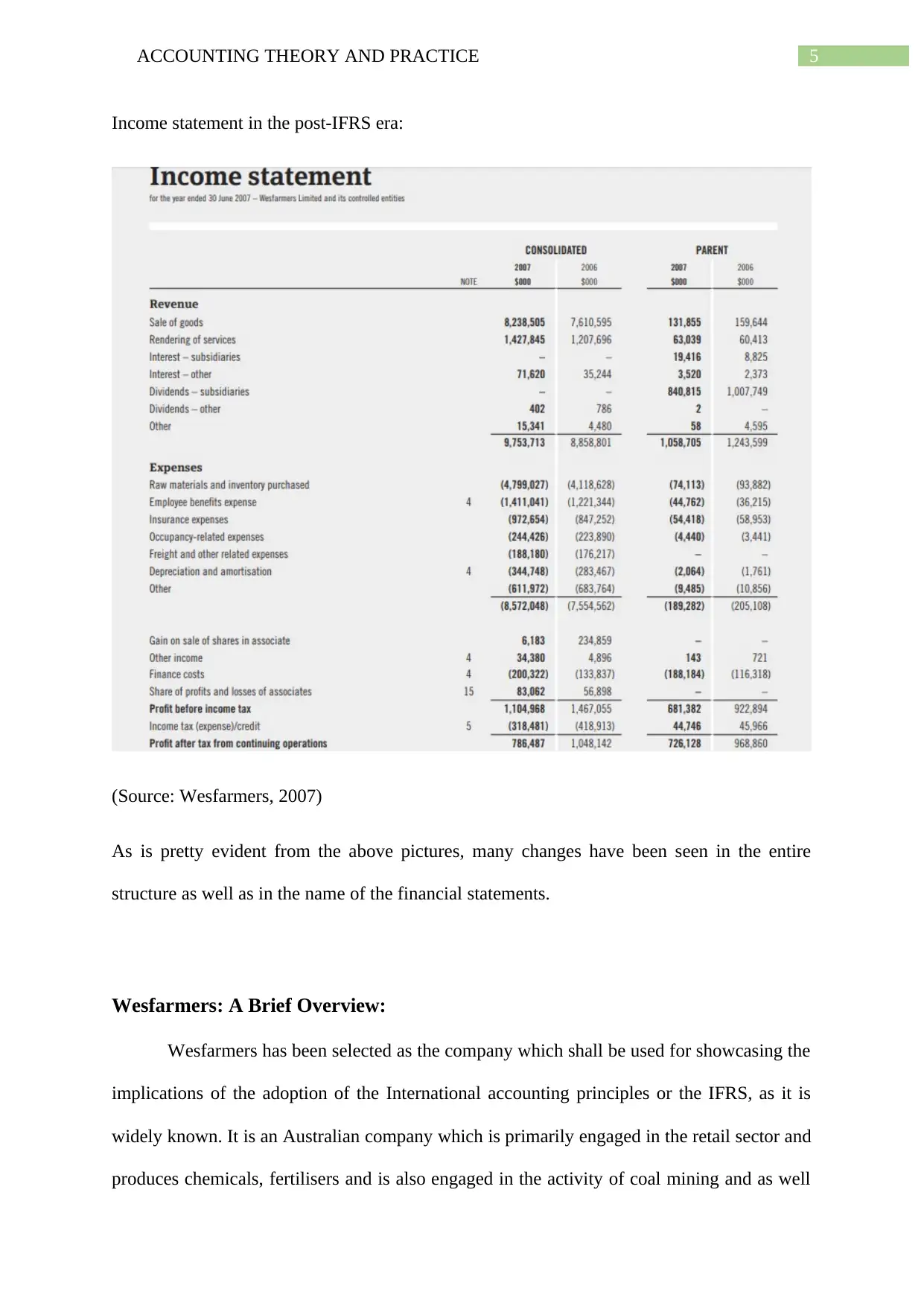
5ACCOUNTING THEORY AND PRACTICE
Income statement in the post-IFRS era:
(Source: Wesfarmers, 2007)
As is pretty evident from the above pictures, many changes have been seen in the entire
structure as well as in the name of the financial statements.
Wesfarmers: A Brief Overview:
Wesfarmers has been selected as the company which shall be used for showcasing the
implications of the adoption of the International accounting principles or the IFRS, as it is
widely known. It is an Australian company which is primarily engaged in the retail sector and
produces chemicals, fertilisers and is also engaged in the activity of coal mining and as well
Income statement in the post-IFRS era:
(Source: Wesfarmers, 2007)
As is pretty evident from the above pictures, many changes have been seen in the entire
structure as well as in the name of the financial statements.
Wesfarmers: A Brief Overview:
Wesfarmers has been selected as the company which shall be used for showcasing the
implications of the adoption of the International accounting principles or the IFRS, as it is
widely known. It is an Australian company which is primarily engaged in the retail sector and
produces chemicals, fertilisers and is also engaged in the activity of coal mining and as well
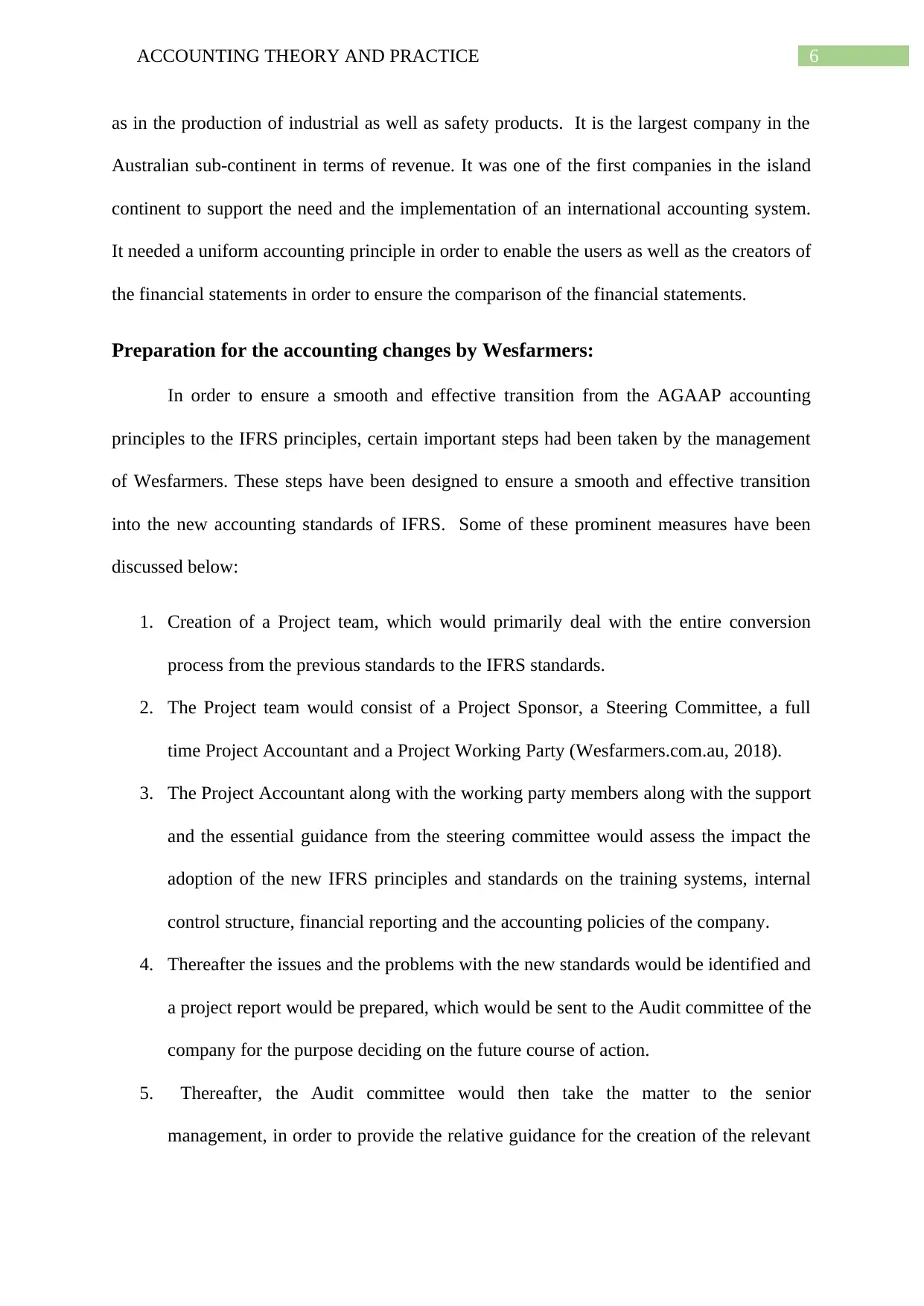
6ACCOUNTING THEORY AND PRACTICE
as in the production of industrial as well as safety products. It is the largest company in the
Australian sub-continent in terms of revenue. It was one of the first companies in the island
continent to support the need and the implementation of an international accounting system.
It needed a uniform accounting principle in order to enable the users as well as the creators of
the financial statements in order to ensure the comparison of the financial statements.
Preparation for the accounting changes by Wesfarmers:
In order to ensure a smooth and effective transition from the AGAAP accounting
principles to the IFRS principles, certain important steps had been taken by the management
of Wesfarmers. These steps have been designed to ensure a smooth and effective transition
into the new accounting standards of IFRS. Some of these prominent measures have been
discussed below:
1. Creation of a Project team, which would primarily deal with the entire conversion
process from the previous standards to the IFRS standards.
2. The Project team would consist of a Project Sponsor, a Steering Committee, a full
time Project Accountant and a Project Working Party (Wesfarmers.com.au, 2018).
3. The Project Accountant along with the working party members along with the support
and the essential guidance from the steering committee would assess the impact the
adoption of the new IFRS principles and standards on the training systems, internal
control structure, financial reporting and the accounting policies of the company.
4. Thereafter the issues and the problems with the new standards would be identified and
a project report would be prepared, which would be sent to the Audit committee of the
company for the purpose deciding on the future course of action.
5. Thereafter, the Audit committee would then take the matter to the senior
management, in order to provide the relative guidance for the creation of the relevant
as in the production of industrial as well as safety products. It is the largest company in the
Australian sub-continent in terms of revenue. It was one of the first companies in the island
continent to support the need and the implementation of an international accounting system.
It needed a uniform accounting principle in order to enable the users as well as the creators of
the financial statements in order to ensure the comparison of the financial statements.
Preparation for the accounting changes by Wesfarmers:
In order to ensure a smooth and effective transition from the AGAAP accounting
principles to the IFRS principles, certain important steps had been taken by the management
of Wesfarmers. These steps have been designed to ensure a smooth and effective transition
into the new accounting standards of IFRS. Some of these prominent measures have been
discussed below:
1. Creation of a Project team, which would primarily deal with the entire conversion
process from the previous standards to the IFRS standards.
2. The Project team would consist of a Project Sponsor, a Steering Committee, a full
time Project Accountant and a Project Working Party (Wesfarmers.com.au, 2018).
3. The Project Accountant along with the working party members along with the support
and the essential guidance from the steering committee would assess the impact the
adoption of the new IFRS principles and standards on the training systems, internal
control structure, financial reporting and the accounting policies of the company.
4. Thereafter the issues and the problems with the new standards would be identified and
a project report would be prepared, which would be sent to the Audit committee of the
company for the purpose deciding on the future course of action.
5. Thereafter, the Audit committee would then take the matter to the senior
management, in order to provide the relative guidance for the creation of the relevant
Paraphrase This Document
Need a fresh take? Get an instant paraphrase of this document with our AI Paraphraser
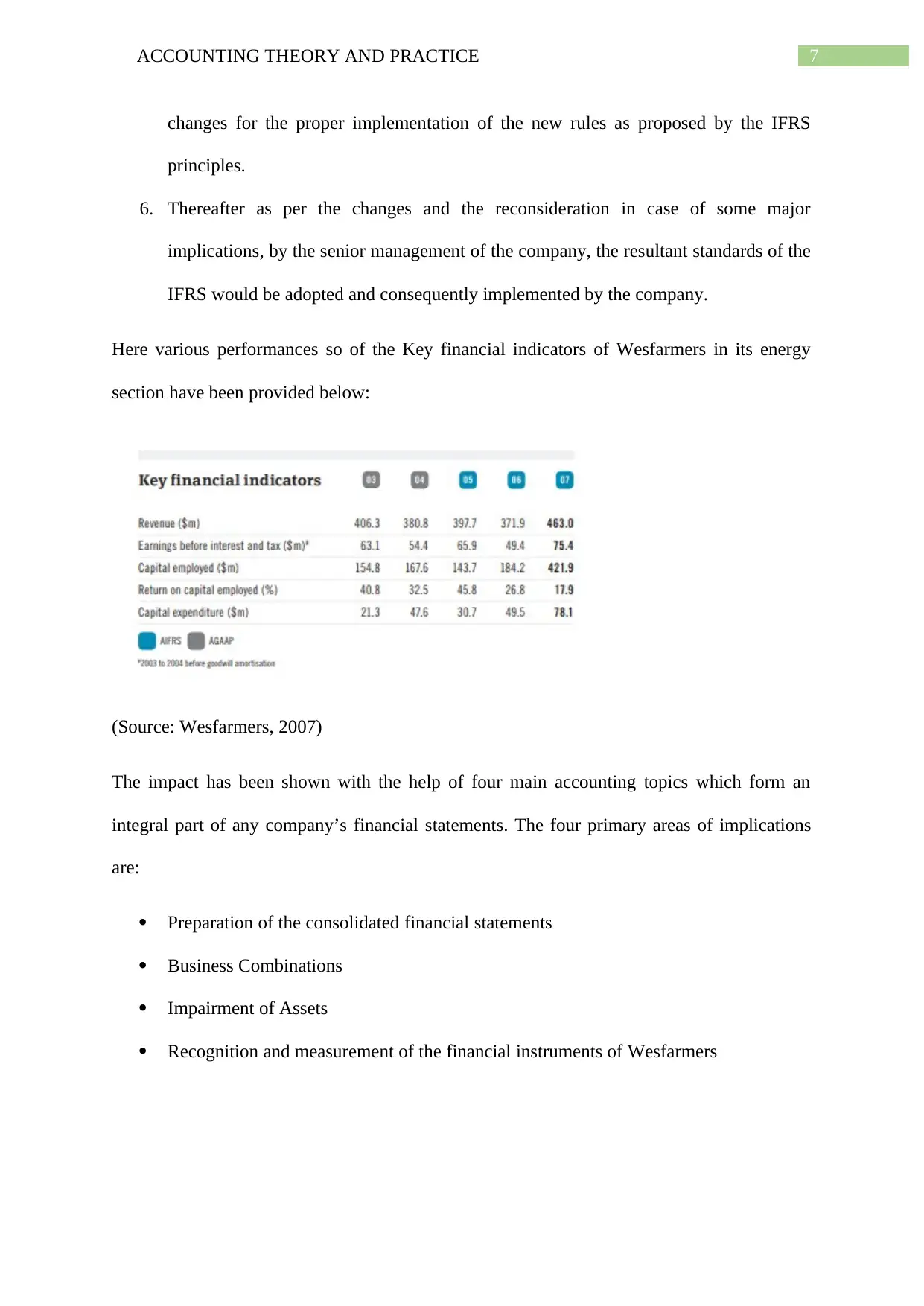
7ACCOUNTING THEORY AND PRACTICE
changes for the proper implementation of the new rules as proposed by the IFRS
principles.
6. Thereafter as per the changes and the reconsideration in case of some major
implications, by the senior management of the company, the resultant standards of the
IFRS would be adopted and consequently implemented by the company.
Here various performances so of the Key financial indicators of Wesfarmers in its energy
section have been provided below:
(Source: Wesfarmers, 2007)
The impact has been shown with the help of four main accounting topics which form an
integral part of any company’s financial statements. The four primary areas of implications
are:
Preparation of the consolidated financial statements
Business Combinations
Impairment of Assets
Recognition and measurement of the financial instruments of Wesfarmers
changes for the proper implementation of the new rules as proposed by the IFRS
principles.
6. Thereafter as per the changes and the reconsideration in case of some major
implications, by the senior management of the company, the resultant standards of the
IFRS would be adopted and consequently implemented by the company.
Here various performances so of the Key financial indicators of Wesfarmers in its energy
section have been provided below:
(Source: Wesfarmers, 2007)
The impact has been shown with the help of four main accounting topics which form an
integral part of any company’s financial statements. The four primary areas of implications
are:
Preparation of the consolidated financial statements
Business Combinations
Impairment of Assets
Recognition and measurement of the financial instruments of Wesfarmers
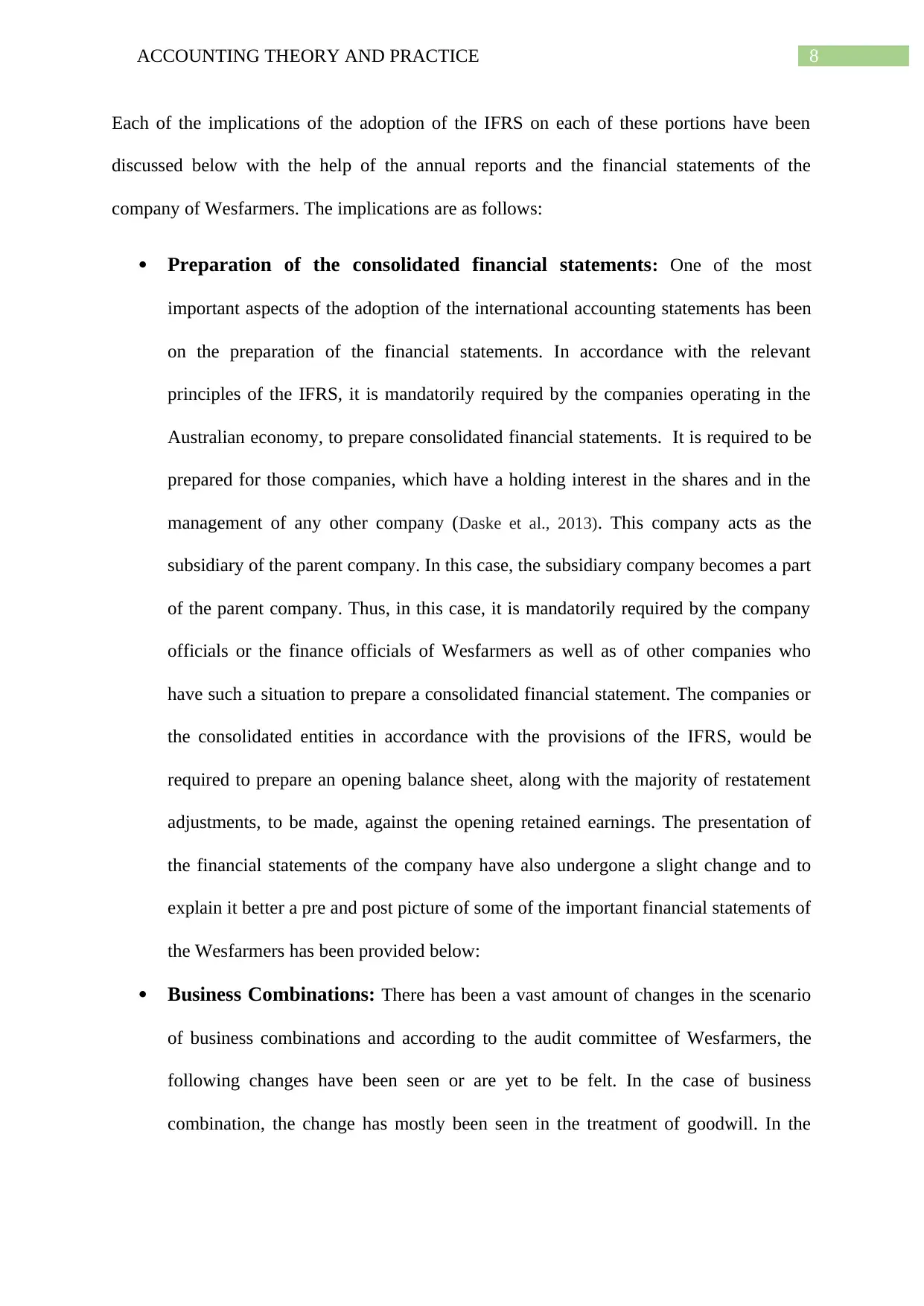
8ACCOUNTING THEORY AND PRACTICE
Each of the implications of the adoption of the IFRS on each of these portions have been
discussed below with the help of the annual reports and the financial statements of the
company of Wesfarmers. The implications are as follows:
Preparation of the consolidated financial statements: One of the most
important aspects of the adoption of the international accounting statements has been
on the preparation of the financial statements. In accordance with the relevant
principles of the IFRS, it is mandatorily required by the companies operating in the
Australian economy, to prepare consolidated financial statements. It is required to be
prepared for those companies, which have a holding interest in the shares and in the
management of any other company (Daske et al., 2013). This company acts as the
subsidiary of the parent company. In this case, the subsidiary company becomes a part
of the parent company. Thus, in this case, it is mandatorily required by the company
officials or the finance officials of Wesfarmers as well as of other companies who
have such a situation to prepare a consolidated financial statement. The companies or
the consolidated entities in accordance with the provisions of the IFRS, would be
required to prepare an opening balance sheet, along with the majority of restatement
adjustments, to be made, against the opening retained earnings. The presentation of
the financial statements of the company have also undergone a slight change and to
explain it better a pre and post picture of some of the important financial statements of
the Wesfarmers has been provided below:
Business Combinations: There has been a vast amount of changes in the scenario
of business combinations and according to the audit committee of Wesfarmers, the
following changes have been seen or are yet to be felt. In the case of business
combination, the change has mostly been seen in the treatment of goodwill. In the
Each of the implications of the adoption of the IFRS on each of these portions have been
discussed below with the help of the annual reports and the financial statements of the
company of Wesfarmers. The implications are as follows:
Preparation of the consolidated financial statements: One of the most
important aspects of the adoption of the international accounting statements has been
on the preparation of the financial statements. In accordance with the relevant
principles of the IFRS, it is mandatorily required by the companies operating in the
Australian economy, to prepare consolidated financial statements. It is required to be
prepared for those companies, which have a holding interest in the shares and in the
management of any other company (Daske et al., 2013). This company acts as the
subsidiary of the parent company. In this case, the subsidiary company becomes a part
of the parent company. Thus, in this case, it is mandatorily required by the company
officials or the finance officials of Wesfarmers as well as of other companies who
have such a situation to prepare a consolidated financial statement. The companies or
the consolidated entities in accordance with the provisions of the IFRS, would be
required to prepare an opening balance sheet, along with the majority of restatement
adjustments, to be made, against the opening retained earnings. The presentation of
the financial statements of the company have also undergone a slight change and to
explain it better a pre and post picture of some of the important financial statements of
the Wesfarmers has been provided below:
Business Combinations: There has been a vast amount of changes in the scenario
of business combinations and according to the audit committee of Wesfarmers, the
following changes have been seen or are yet to be felt. In the case of business
combination, the change has mostly been seen in the treatment of goodwill. In the
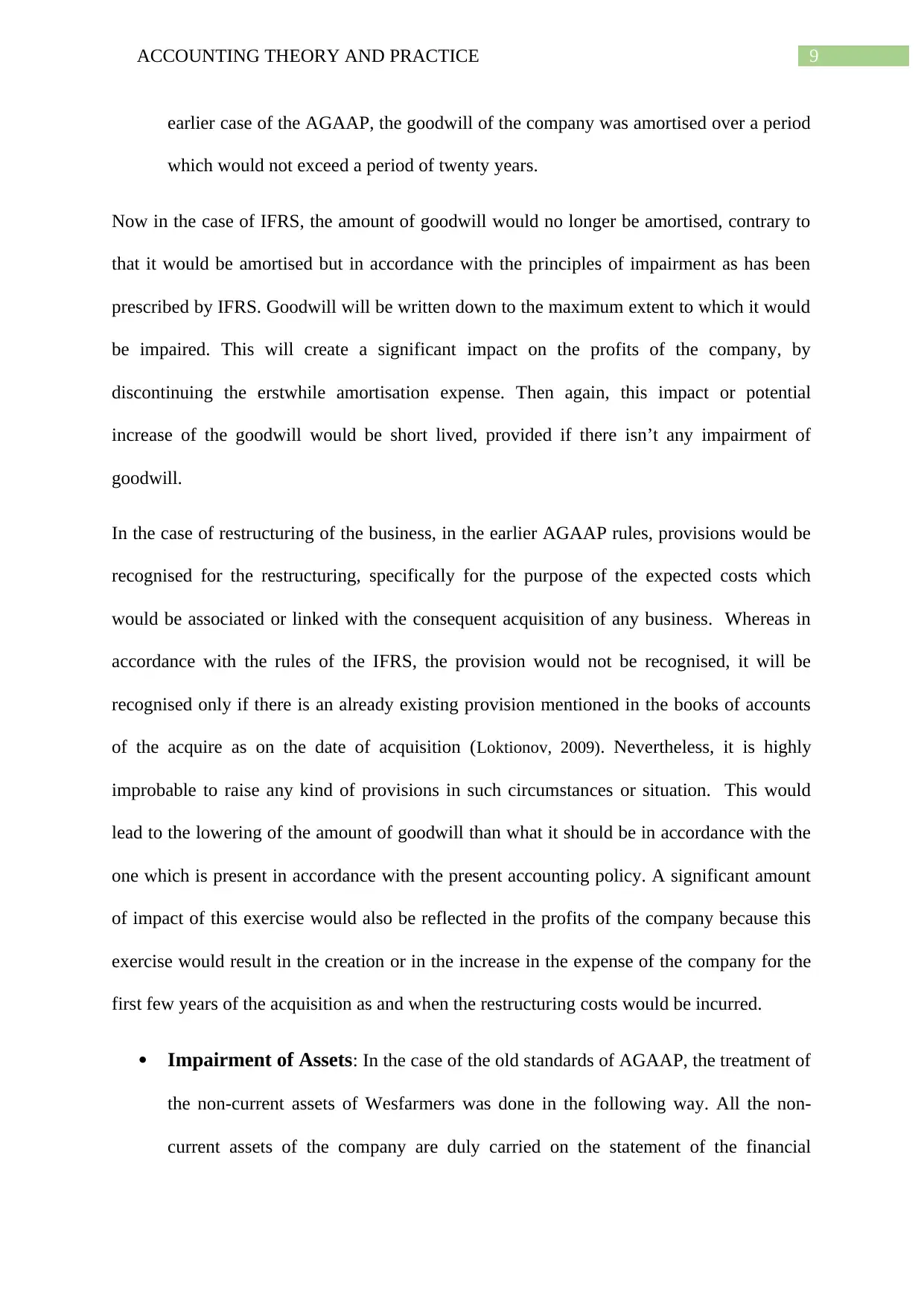
9ACCOUNTING THEORY AND PRACTICE
earlier case of the AGAAP, the goodwill of the company was amortised over a period
which would not exceed a period of twenty years.
Now in the case of IFRS, the amount of goodwill would no longer be amortised, contrary to
that it would be amortised but in accordance with the principles of impairment as has been
prescribed by IFRS. Goodwill will be written down to the maximum extent to which it would
be impaired. This will create a significant impact on the profits of the company, by
discontinuing the erstwhile amortisation expense. Then again, this impact or potential
increase of the goodwill would be short lived, provided if there isn’t any impairment of
goodwill.
In the case of restructuring of the business, in the earlier AGAAP rules, provisions would be
recognised for the restructuring, specifically for the purpose of the expected costs which
would be associated or linked with the consequent acquisition of any business. Whereas in
accordance with the rules of the IFRS, the provision would not be recognised, it will be
recognised only if there is an already existing provision mentioned in the books of accounts
of the acquire as on the date of acquisition (Loktionov, 2009). Nevertheless, it is highly
improbable to raise any kind of provisions in such circumstances or situation. This would
lead to the lowering of the amount of goodwill than what it should be in accordance with the
one which is present in accordance with the present accounting policy. A significant amount
of impact of this exercise would also be reflected in the profits of the company because this
exercise would result in the creation or in the increase in the expense of the company for the
first few years of the acquisition as and when the restructuring costs would be incurred.
Impairment of Assets: In the case of the old standards of AGAAP, the treatment of
the non-current assets of Wesfarmers was done in the following way. All the non-
current assets of the company are duly carried on the statement of the financial
earlier case of the AGAAP, the goodwill of the company was amortised over a period
which would not exceed a period of twenty years.
Now in the case of IFRS, the amount of goodwill would no longer be amortised, contrary to
that it would be amortised but in accordance with the principles of impairment as has been
prescribed by IFRS. Goodwill will be written down to the maximum extent to which it would
be impaired. This will create a significant impact on the profits of the company, by
discontinuing the erstwhile amortisation expense. Then again, this impact or potential
increase of the goodwill would be short lived, provided if there isn’t any impairment of
goodwill.
In the case of restructuring of the business, in the earlier AGAAP rules, provisions would be
recognised for the restructuring, specifically for the purpose of the expected costs which
would be associated or linked with the consequent acquisition of any business. Whereas in
accordance with the rules of the IFRS, the provision would not be recognised, it will be
recognised only if there is an already existing provision mentioned in the books of accounts
of the acquire as on the date of acquisition (Loktionov, 2009). Nevertheless, it is highly
improbable to raise any kind of provisions in such circumstances or situation. This would
lead to the lowering of the amount of goodwill than what it should be in accordance with the
one which is present in accordance with the present accounting policy. A significant amount
of impact of this exercise would also be reflected in the profits of the company because this
exercise would result in the creation or in the increase in the expense of the company for the
first few years of the acquisition as and when the restructuring costs would be incurred.
Impairment of Assets: In the case of the old standards of AGAAP, the treatment of
the non-current assets of Wesfarmers was done in the following way. All the non-
current assets of the company are duly carried on the statement of the financial
Secure Best Marks with AI Grader
Need help grading? Try our AI Grader for instant feedback on your assignments.
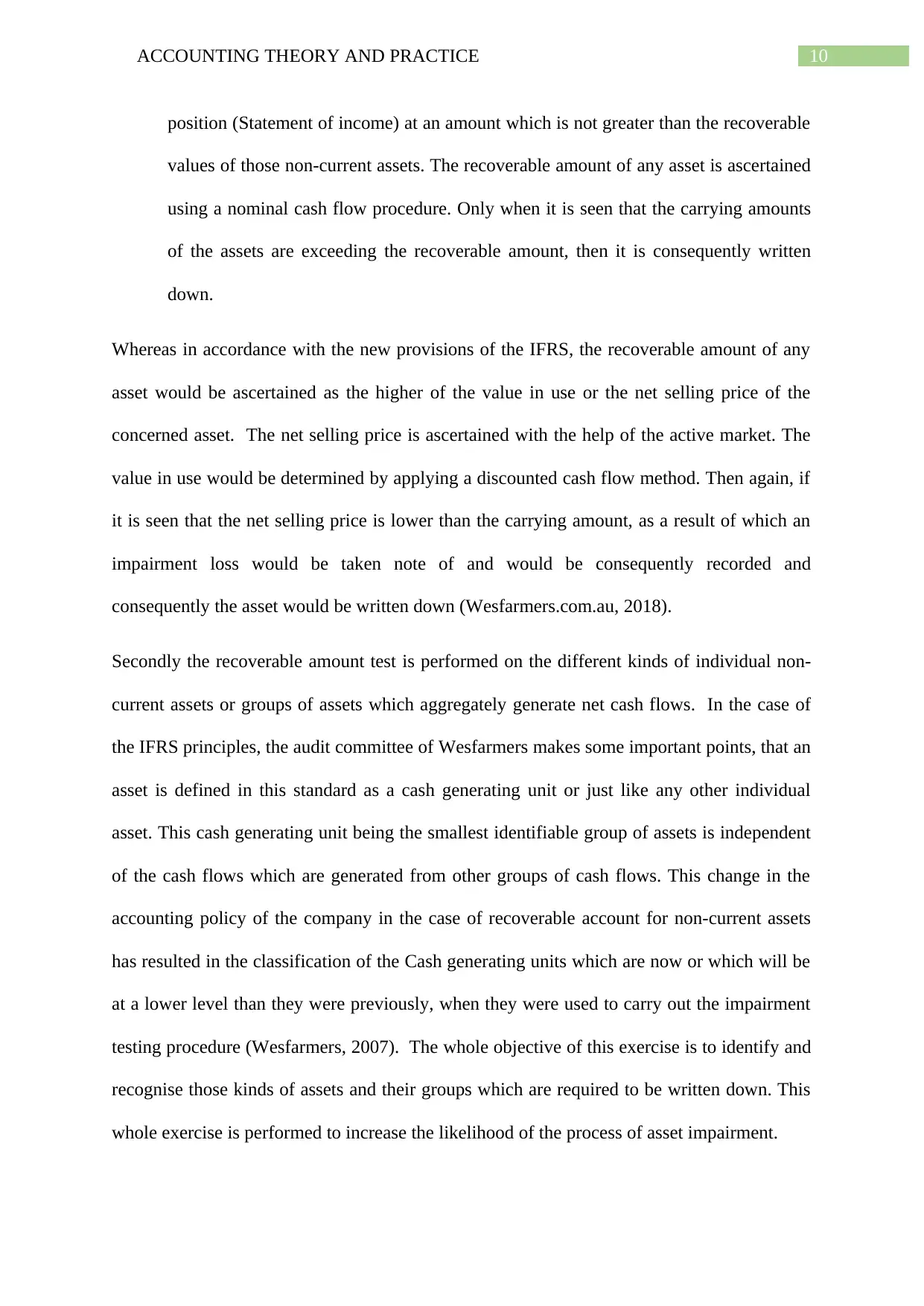
10ACCOUNTING THEORY AND PRACTICE
position (Statement of income) at an amount which is not greater than the recoverable
values of those non-current assets. The recoverable amount of any asset is ascertained
using a nominal cash flow procedure. Only when it is seen that the carrying amounts
of the assets are exceeding the recoverable amount, then it is consequently written
down.
Whereas in accordance with the new provisions of the IFRS, the recoverable amount of any
asset would be ascertained as the higher of the value in use or the net selling price of the
concerned asset. The net selling price is ascertained with the help of the active market. The
value in use would be determined by applying a discounted cash flow method. Then again, if
it is seen that the net selling price is lower than the carrying amount, as a result of which an
impairment loss would be taken note of and would be consequently recorded and
consequently the asset would be written down (Wesfarmers.com.au, 2018).
Secondly the recoverable amount test is performed on the different kinds of individual non-
current assets or groups of assets which aggregately generate net cash flows. In the case of
the IFRS principles, the audit committee of Wesfarmers makes some important points, that an
asset is defined in this standard as a cash generating unit or just like any other individual
asset. This cash generating unit being the smallest identifiable group of assets is independent
of the cash flows which are generated from other groups of cash flows. This change in the
accounting policy of the company in the case of recoverable account for non-current assets
has resulted in the classification of the Cash generating units which are now or which will be
at a lower level than they were previously, when they were used to carry out the impairment
testing procedure (Wesfarmers, 2007). The whole objective of this exercise is to identify and
recognise those kinds of assets and their groups which are required to be written down. This
whole exercise is performed to increase the likelihood of the process of asset impairment.
position (Statement of income) at an amount which is not greater than the recoverable
values of those non-current assets. The recoverable amount of any asset is ascertained
using a nominal cash flow procedure. Only when it is seen that the carrying amounts
of the assets are exceeding the recoverable amount, then it is consequently written
down.
Whereas in accordance with the new provisions of the IFRS, the recoverable amount of any
asset would be ascertained as the higher of the value in use or the net selling price of the
concerned asset. The net selling price is ascertained with the help of the active market. The
value in use would be determined by applying a discounted cash flow method. Then again, if
it is seen that the net selling price is lower than the carrying amount, as a result of which an
impairment loss would be taken note of and would be consequently recorded and
consequently the asset would be written down (Wesfarmers.com.au, 2018).
Secondly the recoverable amount test is performed on the different kinds of individual non-
current assets or groups of assets which aggregately generate net cash flows. In the case of
the IFRS principles, the audit committee of Wesfarmers makes some important points, that an
asset is defined in this standard as a cash generating unit or just like any other individual
asset. This cash generating unit being the smallest identifiable group of assets is independent
of the cash flows which are generated from other groups of cash flows. This change in the
accounting policy of the company in the case of recoverable account for non-current assets
has resulted in the classification of the Cash generating units which are now or which will be
at a lower level than they were previously, when they were used to carry out the impairment
testing procedure (Wesfarmers, 2007). The whole objective of this exercise is to identify and
recognise those kinds of assets and their groups which are required to be written down. This
whole exercise is performed to increase the likelihood of the process of asset impairment.
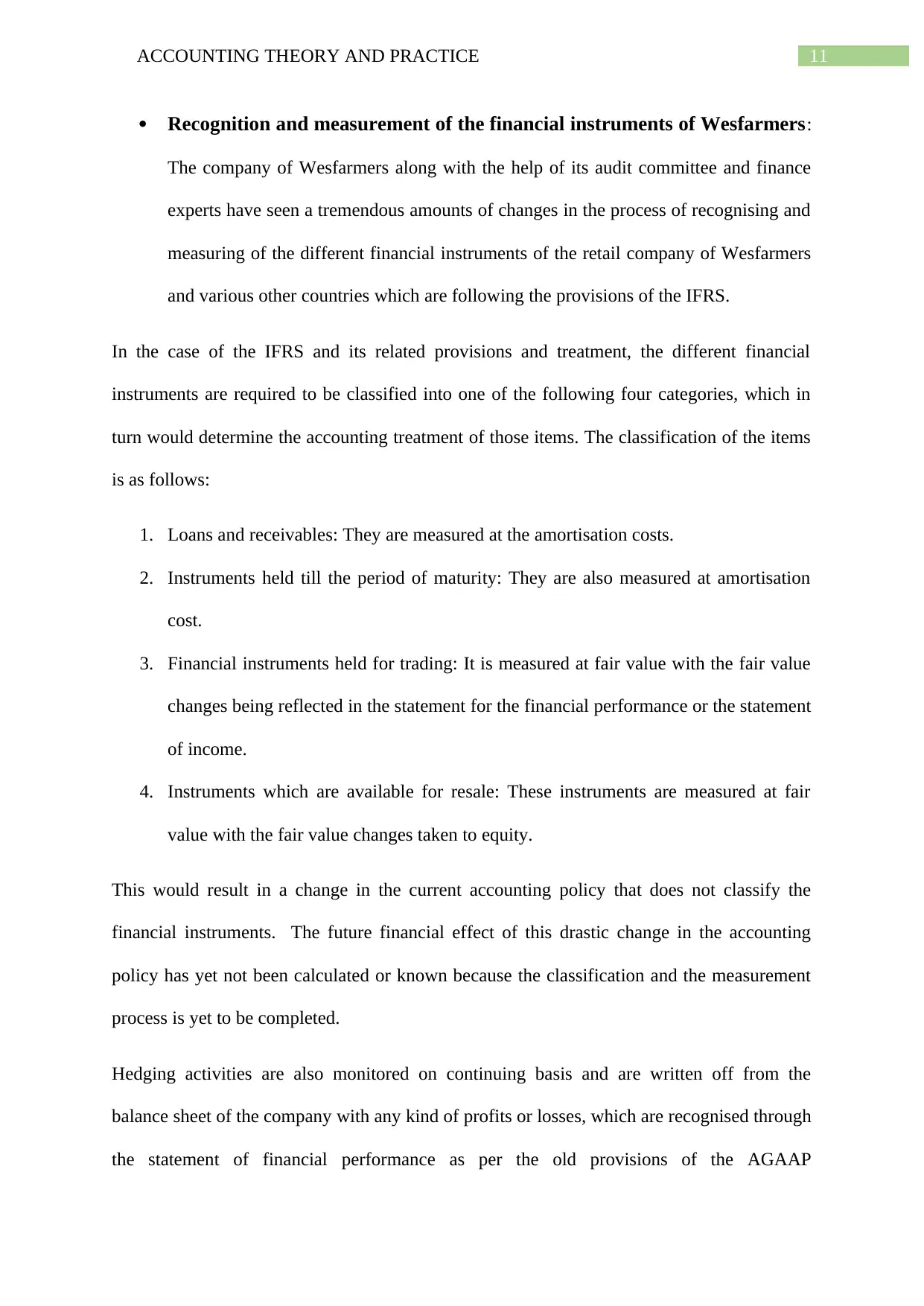
11ACCOUNTING THEORY AND PRACTICE
Recognition and measurement of the financial instruments of Wesfarmers:
The company of Wesfarmers along with the help of its audit committee and finance
experts have seen a tremendous amounts of changes in the process of recognising and
measuring of the different financial instruments of the retail company of Wesfarmers
and various other countries which are following the provisions of the IFRS.
In the case of the IFRS and its related provisions and treatment, the different financial
instruments are required to be classified into one of the following four categories, which in
turn would determine the accounting treatment of those items. The classification of the items
is as follows:
1. Loans and receivables: They are measured at the amortisation costs.
2. Instruments held till the period of maturity: They are also measured at amortisation
cost.
3. Financial instruments held for trading: It is measured at fair value with the fair value
changes being reflected in the statement for the financial performance or the statement
of income.
4. Instruments which are available for resale: These instruments are measured at fair
value with the fair value changes taken to equity.
This would result in a change in the current accounting policy that does not classify the
financial instruments. The future financial effect of this drastic change in the accounting
policy has yet not been calculated or known because the classification and the measurement
process is yet to be completed.
Hedging activities are also monitored on continuing basis and are written off from the
balance sheet of the company with any kind of profits or losses, which are recognised through
the statement of financial performance as per the old provisions of the AGAAP
Recognition and measurement of the financial instruments of Wesfarmers:
The company of Wesfarmers along with the help of its audit committee and finance
experts have seen a tremendous amounts of changes in the process of recognising and
measuring of the different financial instruments of the retail company of Wesfarmers
and various other countries which are following the provisions of the IFRS.
In the case of the IFRS and its related provisions and treatment, the different financial
instruments are required to be classified into one of the following four categories, which in
turn would determine the accounting treatment of those items. The classification of the items
is as follows:
1. Loans and receivables: They are measured at the amortisation costs.
2. Instruments held till the period of maturity: They are also measured at amortisation
cost.
3. Financial instruments held for trading: It is measured at fair value with the fair value
changes being reflected in the statement for the financial performance or the statement
of income.
4. Instruments which are available for resale: These instruments are measured at fair
value with the fair value changes taken to equity.
This would result in a change in the current accounting policy that does not classify the
financial instruments. The future financial effect of this drastic change in the accounting
policy has yet not been calculated or known because the classification and the measurement
process is yet to be completed.
Hedging activities are also monitored on continuing basis and are written off from the
balance sheet of the company with any kind of profits or losses, which are recognised through
the statement of financial performance as per the old provisions of the AGAAP
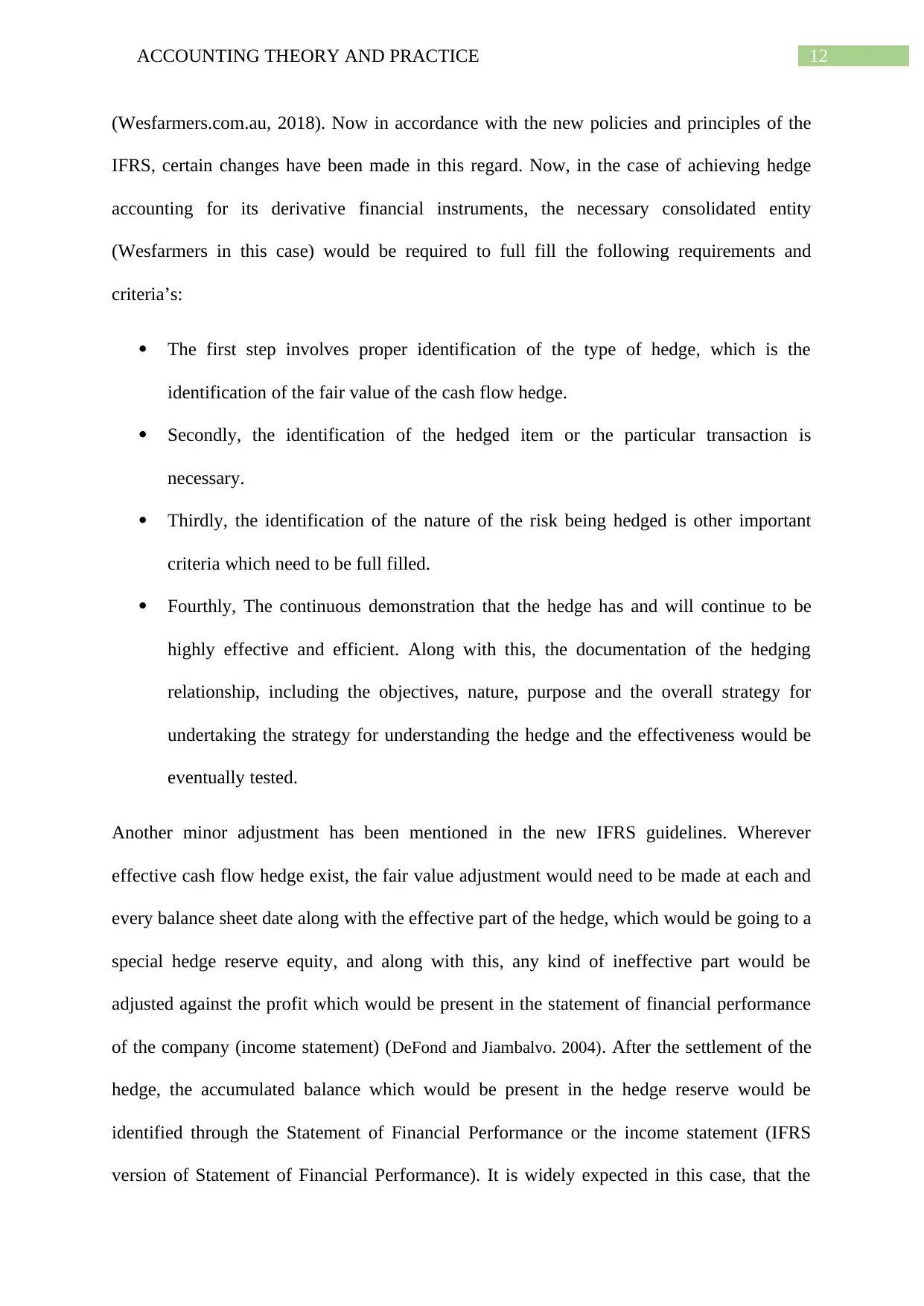
12ACCOUNTING THEORY AND PRACTICE
(Wesfarmers.com.au, 2018). Now in accordance with the new policies and principles of the
IFRS, certain changes have been made in this regard. Now, in the case of achieving hedge
accounting for its derivative financial instruments, the necessary consolidated entity
(Wesfarmers in this case) would be required to full fill the following requirements and
criteria’s:
The first step involves proper identification of the type of hedge, which is the
identification of the fair value of the cash flow hedge.
Secondly, the identification of the hedged item or the particular transaction is
necessary.
Thirdly, the identification of the nature of the risk being hedged is other important
criteria which need to be full filled.
Fourthly, The continuous demonstration that the hedge has and will continue to be
highly effective and efficient. Along with this, the documentation of the hedging
relationship, including the objectives, nature, purpose and the overall strategy for
undertaking the strategy for understanding the hedge and the effectiveness would be
eventually tested.
Another minor adjustment has been mentioned in the new IFRS guidelines. Wherever
effective cash flow hedge exist, the fair value adjustment would need to be made at each and
every balance sheet date along with the effective part of the hedge, which would be going to a
special hedge reserve equity, and along with this, any kind of ineffective part would be
adjusted against the profit which would be present in the statement of financial performance
of the company (income statement) (DeFond and Jiambalvo. 2004). After the settlement of the
hedge, the accumulated balance which would be present in the hedge reserve would be
identified through the Statement of Financial Performance or the income statement (IFRS
version of Statement of Financial Performance). It is widely expected in this case, that the
(Wesfarmers.com.au, 2018). Now in accordance with the new policies and principles of the
IFRS, certain changes have been made in this regard. Now, in the case of achieving hedge
accounting for its derivative financial instruments, the necessary consolidated entity
(Wesfarmers in this case) would be required to full fill the following requirements and
criteria’s:
The first step involves proper identification of the type of hedge, which is the
identification of the fair value of the cash flow hedge.
Secondly, the identification of the hedged item or the particular transaction is
necessary.
Thirdly, the identification of the nature of the risk being hedged is other important
criteria which need to be full filled.
Fourthly, The continuous demonstration that the hedge has and will continue to be
highly effective and efficient. Along with this, the documentation of the hedging
relationship, including the objectives, nature, purpose and the overall strategy for
undertaking the strategy for understanding the hedge and the effectiveness would be
eventually tested.
Another minor adjustment has been mentioned in the new IFRS guidelines. Wherever
effective cash flow hedge exist, the fair value adjustment would need to be made at each and
every balance sheet date along with the effective part of the hedge, which would be going to a
special hedge reserve equity, and along with this, any kind of ineffective part would be
adjusted against the profit which would be present in the statement of financial performance
of the company (income statement) (DeFond and Jiambalvo. 2004). After the settlement of the
hedge, the accumulated balance which would be present in the hedge reserve would be
identified through the Statement of Financial Performance or the income statement (IFRS
version of Statement of Financial Performance). It is widely expected in this case, that the
Paraphrase This Document
Need a fresh take? Get an instant paraphrase of this document with our AI Paraphraser
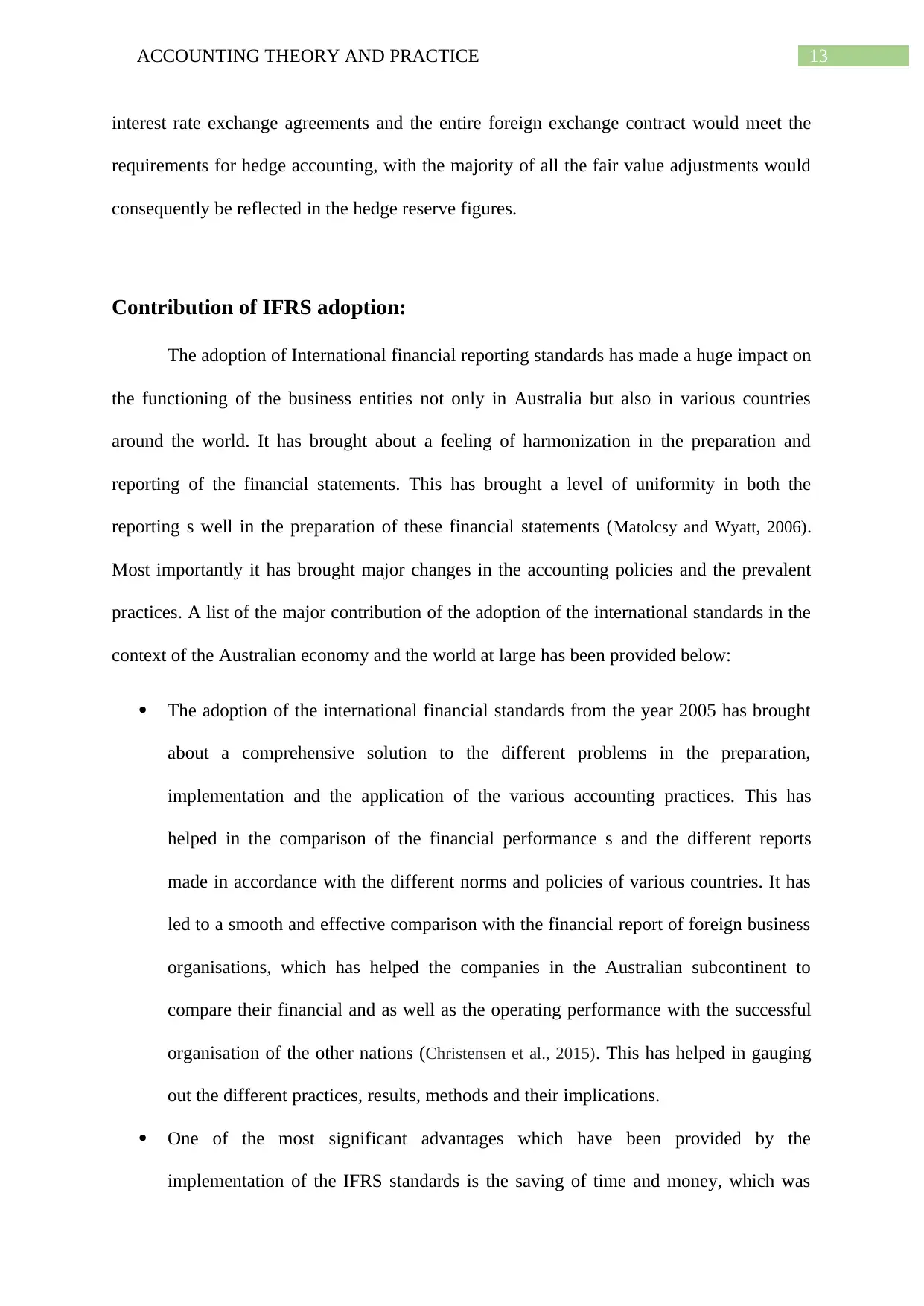
13ACCOUNTING THEORY AND PRACTICE
interest rate exchange agreements and the entire foreign exchange contract would meet the
requirements for hedge accounting, with the majority of all the fair value adjustments would
consequently be reflected in the hedge reserve figures.
Contribution of IFRS adoption:
The adoption of International financial reporting standards has made a huge impact on
the functioning of the business entities not only in Australia but also in various countries
around the world. It has brought about a feeling of harmonization in the preparation and
reporting of the financial statements. This has brought a level of uniformity in both the
reporting s well in the preparation of these financial statements (Matolcsy and Wyatt, 2006).
Most importantly it has brought major changes in the accounting policies and the prevalent
practices. A list of the major contribution of the adoption of the international standards in the
context of the Australian economy and the world at large has been provided below:
The adoption of the international financial standards from the year 2005 has brought
about a comprehensive solution to the different problems in the preparation,
implementation and the application of the various accounting practices. This has
helped in the comparison of the financial performance s and the different reports
made in accordance with the different norms and policies of various countries. It has
led to a smooth and effective comparison with the financial report of foreign business
organisations, which has helped the companies in the Australian subcontinent to
compare their financial and as well as the operating performance with the successful
organisation of the other nations (Christensen et al., 2015). This has helped in gauging
out the different practices, results, methods and their implications.
One of the most significant advantages which have been provided by the
implementation of the IFRS standards is the saving of time and money, which was
interest rate exchange agreements and the entire foreign exchange contract would meet the
requirements for hedge accounting, with the majority of all the fair value adjustments would
consequently be reflected in the hedge reserve figures.
Contribution of IFRS adoption:
The adoption of International financial reporting standards has made a huge impact on
the functioning of the business entities not only in Australia but also in various countries
around the world. It has brought about a feeling of harmonization in the preparation and
reporting of the financial statements. This has brought a level of uniformity in both the
reporting s well in the preparation of these financial statements (Matolcsy and Wyatt, 2006).
Most importantly it has brought major changes in the accounting policies and the prevalent
practices. A list of the major contribution of the adoption of the international standards in the
context of the Australian economy and the world at large has been provided below:
The adoption of the international financial standards from the year 2005 has brought
about a comprehensive solution to the different problems in the preparation,
implementation and the application of the various accounting practices. This has
helped in the comparison of the financial performance s and the different reports
made in accordance with the different norms and policies of various countries. It has
led to a smooth and effective comparison with the financial report of foreign business
organisations, which has helped the companies in the Australian subcontinent to
compare their financial and as well as the operating performance with the successful
organisation of the other nations (Christensen et al., 2015). This has helped in gauging
out the different practices, results, methods and their implications.
One of the most significant advantages which have been provided by the
implementation of the IFRS standards is the saving of time and money, which was
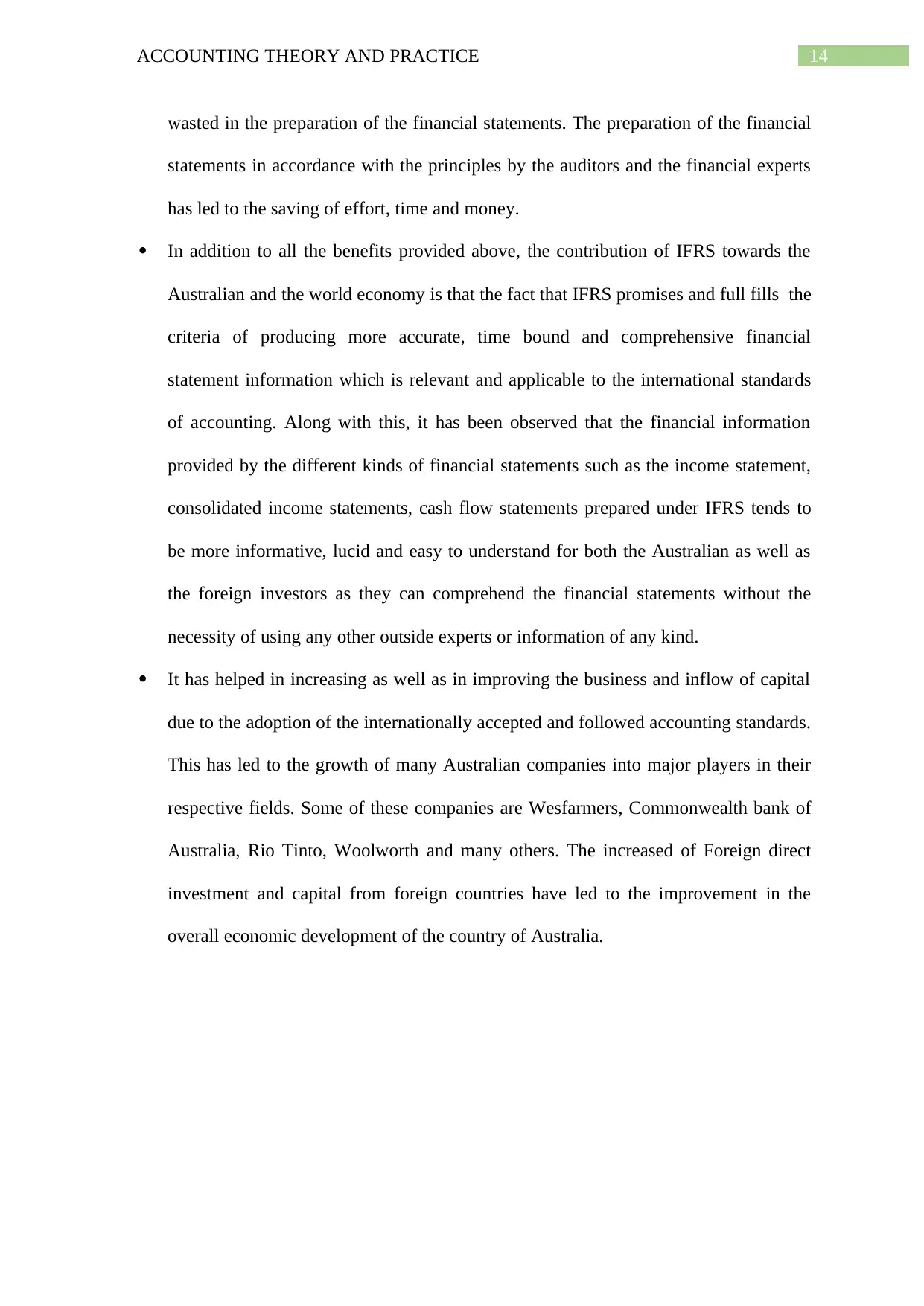
14ACCOUNTING THEORY AND PRACTICE
wasted in the preparation of the financial statements. The preparation of the financial
statements in accordance with the principles by the auditors and the financial experts
has led to the saving of effort, time and money.
In addition to all the benefits provided above, the contribution of IFRS towards the
Australian and the world economy is that the fact that IFRS promises and full fills the
criteria of producing more accurate, time bound and comprehensive financial
statement information which is relevant and applicable to the international standards
of accounting. Along with this, it has been observed that the financial information
provided by the different kinds of financial statements such as the income statement,
consolidated income statements, cash flow statements prepared under IFRS tends to
be more informative, lucid and easy to understand for both the Australian as well as
the foreign investors as they can comprehend the financial statements without the
necessity of using any other outside experts or information of any kind.
It has helped in increasing as well as in improving the business and inflow of capital
due to the adoption of the internationally accepted and followed accounting standards.
This has led to the growth of many Australian companies into major players in their
respective fields. Some of these companies are Wesfarmers, Commonwealth bank of
Australia, Rio Tinto, Woolworth and many others. The increased of Foreign direct
investment and capital from foreign countries have led to the improvement in the
overall economic development of the country of Australia.
wasted in the preparation of the financial statements. The preparation of the financial
statements in accordance with the principles by the auditors and the financial experts
has led to the saving of effort, time and money.
In addition to all the benefits provided above, the contribution of IFRS towards the
Australian and the world economy is that the fact that IFRS promises and full fills the
criteria of producing more accurate, time bound and comprehensive financial
statement information which is relevant and applicable to the international standards
of accounting. Along with this, it has been observed that the financial information
provided by the different kinds of financial statements such as the income statement,
consolidated income statements, cash flow statements prepared under IFRS tends to
be more informative, lucid and easy to understand for both the Australian as well as
the foreign investors as they can comprehend the financial statements without the
necessity of using any other outside experts or information of any kind.
It has helped in increasing as well as in improving the business and inflow of capital
due to the adoption of the internationally accepted and followed accounting standards.
This has led to the growth of many Australian companies into major players in their
respective fields. Some of these companies are Wesfarmers, Commonwealth bank of
Australia, Rio Tinto, Woolworth and many others. The increased of Foreign direct
investment and capital from foreign countries have led to the improvement in the
overall economic development of the country of Australia.
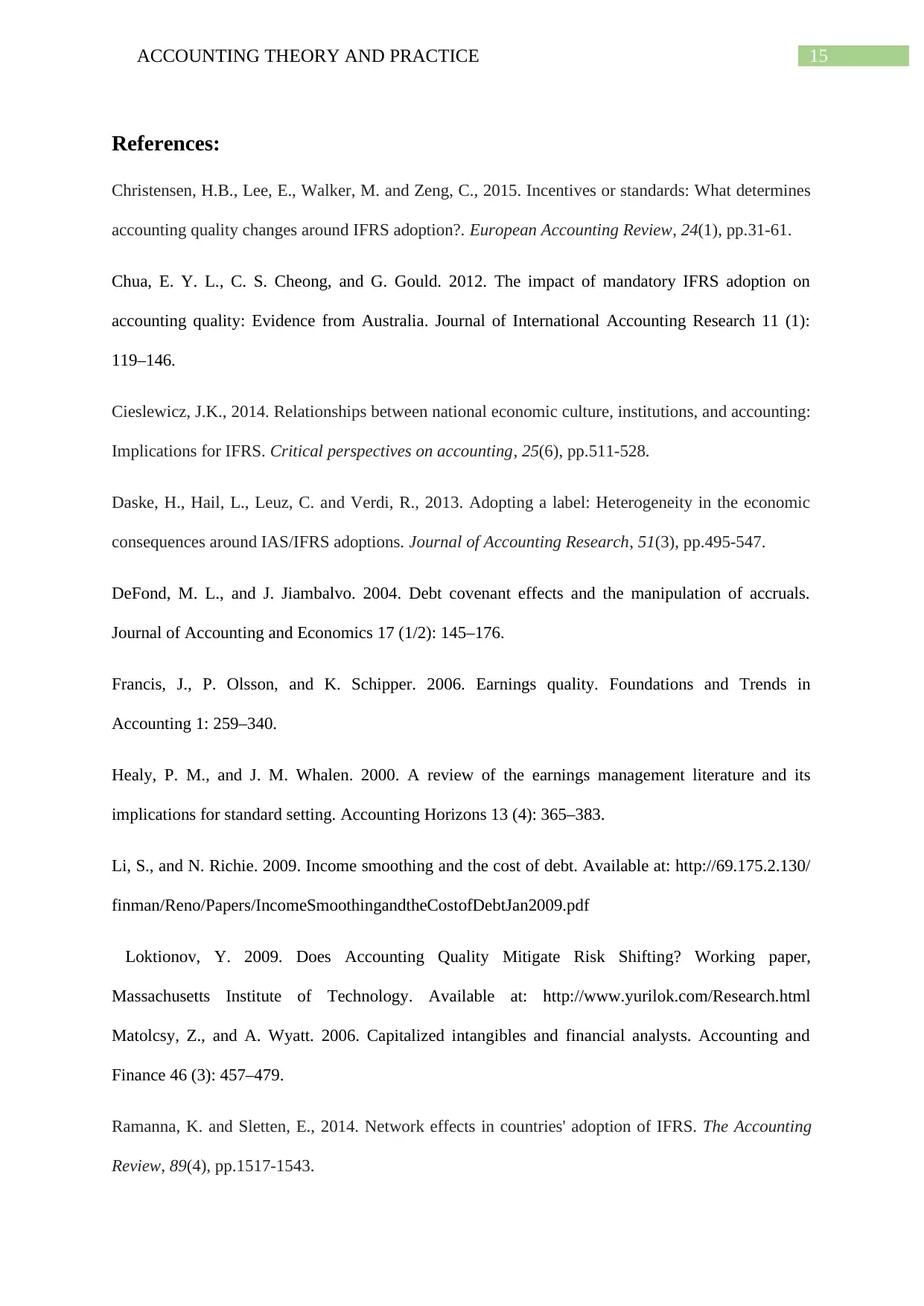
15ACCOUNTING THEORY AND PRACTICE
References:
Christensen, H.B., Lee, E., Walker, M. and Zeng, C., 2015. Incentives or standards: What determines
accounting quality changes around IFRS adoption?. European Accounting Review, 24(1), pp.31-61.
Chua, E. Y. L., C. S. Cheong, and G. Gould. 2012. The impact of mandatory IFRS adoption on
accounting quality: Evidence from Australia. Journal of International Accounting Research 11 (1):
119–146.
Cieslewicz, J.K., 2014. Relationships between national economic culture, institutions, and accounting:
Implications for IFRS. Critical perspectives on accounting, 25(6), pp.511-528.
Daske, H., Hail, L., Leuz, C. and Verdi, R., 2013. Adopting a label: Heterogeneity in the economic
consequences around IAS/IFRS adoptions. Journal of Accounting Research, 51(3), pp.495-547.
DeFond, M. L., and J. Jiambalvo. 2004. Debt covenant effects and the manipulation of accruals.
Journal of Accounting and Economics 17 (1/2): 145–176.
Francis, J., P. Olsson, and K. Schipper. 2006. Earnings quality. Foundations and Trends in
Accounting 1: 259–340.
Healy, P. M., and J. M. Whalen. 2000. A review of the earnings management literature and its
implications for standard setting. Accounting Horizons 13 (4): 365–383.
Li, S., and N. Richie. 2009. Income smoothing and the cost of debt. Available at: http://69.175.2.130/
finman/Reno/Papers/IncomeSmoothingandtheCostofDebtJan2009.pdf
Loktionov, Y. 2009. Does Accounting Quality Mitigate Risk Shifting? Working paper,
Massachusetts Institute of Technology. Available at: http://www.yurilok.com/Research.html
Matolcsy, Z., and A. Wyatt. 2006. Capitalized intangibles and financial analysts. Accounting and
Finance 46 (3): 457–479.
Ramanna, K. and Sletten, E., 2014. Network effects in countries' adoption of IFRS. The Accounting
Review, 89(4), pp.1517-1543.
References:
Christensen, H.B., Lee, E., Walker, M. and Zeng, C., 2015. Incentives or standards: What determines
accounting quality changes around IFRS adoption?. European Accounting Review, 24(1), pp.31-61.
Chua, E. Y. L., C. S. Cheong, and G. Gould. 2012. The impact of mandatory IFRS adoption on
accounting quality: Evidence from Australia. Journal of International Accounting Research 11 (1):
119–146.
Cieslewicz, J.K., 2014. Relationships between national economic culture, institutions, and accounting:
Implications for IFRS. Critical perspectives on accounting, 25(6), pp.511-528.
Daske, H., Hail, L., Leuz, C. and Verdi, R., 2013. Adopting a label: Heterogeneity in the economic
consequences around IAS/IFRS adoptions. Journal of Accounting Research, 51(3), pp.495-547.
DeFond, M. L., and J. Jiambalvo. 2004. Debt covenant effects and the manipulation of accruals.
Journal of Accounting and Economics 17 (1/2): 145–176.
Francis, J., P. Olsson, and K. Schipper. 2006. Earnings quality. Foundations and Trends in
Accounting 1: 259–340.
Healy, P. M., and J. M. Whalen. 2000. A review of the earnings management literature and its
implications for standard setting. Accounting Horizons 13 (4): 365–383.
Li, S., and N. Richie. 2009. Income smoothing and the cost of debt. Available at: http://69.175.2.130/
finman/Reno/Papers/IncomeSmoothingandtheCostofDebtJan2009.pdf
Loktionov, Y. 2009. Does Accounting Quality Mitigate Risk Shifting? Working paper,
Massachusetts Institute of Technology. Available at: http://www.yurilok.com/Research.html
Matolcsy, Z., and A. Wyatt. 2006. Capitalized intangibles and financial analysts. Accounting and
Finance 46 (3): 457–479.
Ramanna, K. and Sletten, E., 2014. Network effects in countries' adoption of IFRS. The Accounting
Review, 89(4), pp.1517-1543.
Secure Best Marks with AI Grader
Need help grading? Try our AI Grader for instant feedback on your assignments.
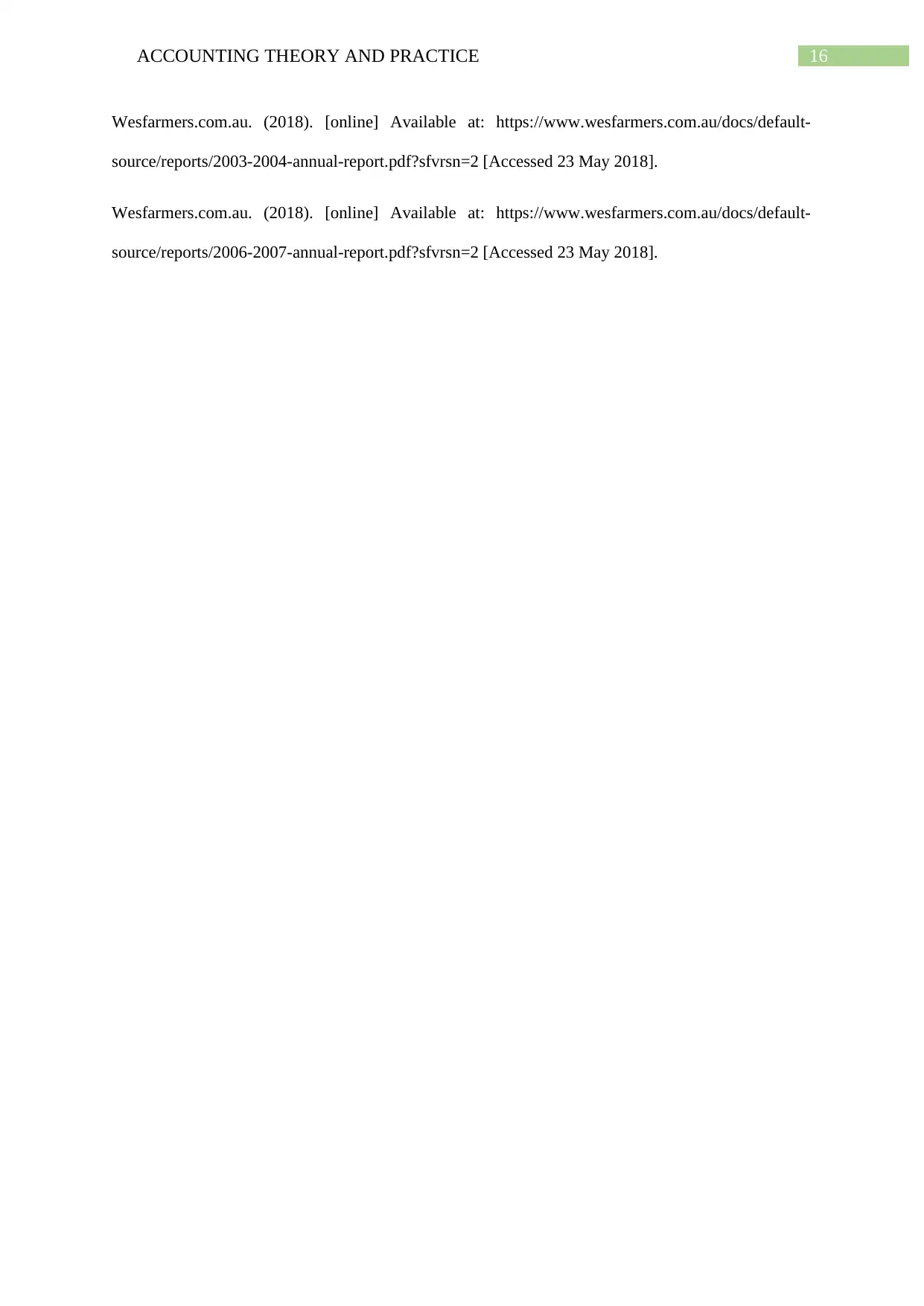
16ACCOUNTING THEORY AND PRACTICE
Wesfarmers.com.au. (2018). [online] Available at: https://www.wesfarmers.com.au/docs/default-
source/reports/2003-2004-annual-report.pdf?sfvrsn=2 [Accessed 23 May 2018].
Wesfarmers.com.au. (2018). [online] Available at: https://www.wesfarmers.com.au/docs/default-
source/reports/2006-2007-annual-report.pdf?sfvrsn=2 [Accessed 23 May 2018].
Wesfarmers.com.au. (2018). [online] Available at: https://www.wesfarmers.com.au/docs/default-
source/reports/2003-2004-annual-report.pdf?sfvrsn=2 [Accessed 23 May 2018].
Wesfarmers.com.au. (2018). [online] Available at: https://www.wesfarmers.com.au/docs/default-
source/reports/2006-2007-annual-report.pdf?sfvrsn=2 [Accessed 23 May 2018].
1 out of 17
Related Documents
Your All-in-One AI-Powered Toolkit for Academic Success.
+13062052269
info@desklib.com
Available 24*7 on WhatsApp / Email
![[object Object]](/_next/static/media/star-bottom.7253800d.svg)
Unlock your academic potential
© 2024 | Zucol Services PVT LTD | All rights reserved.





